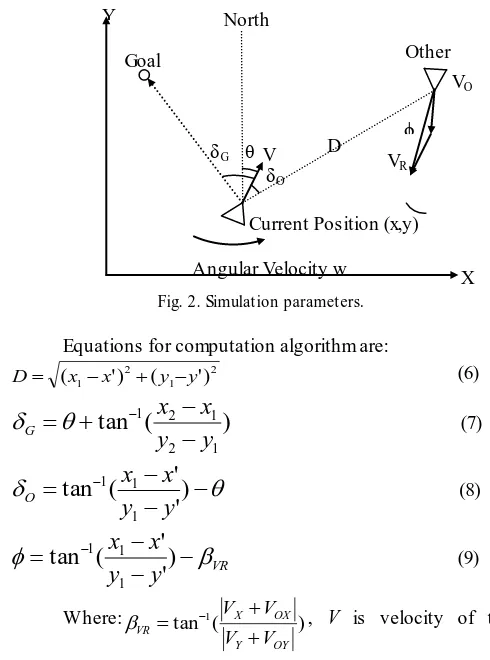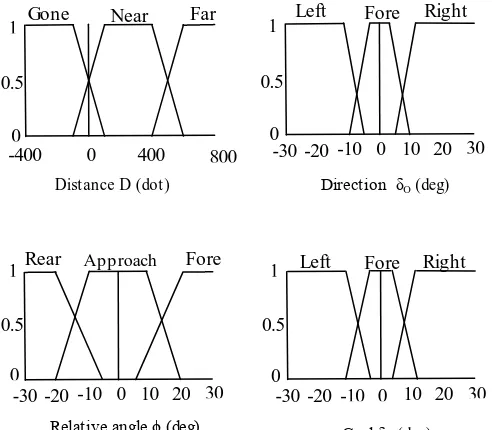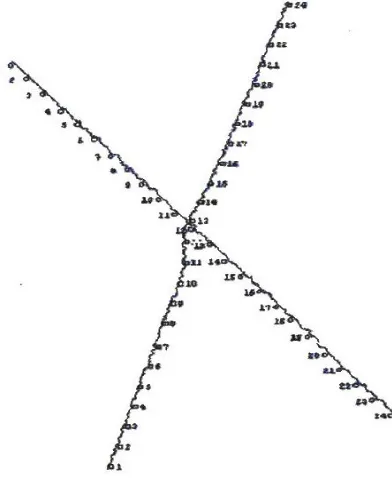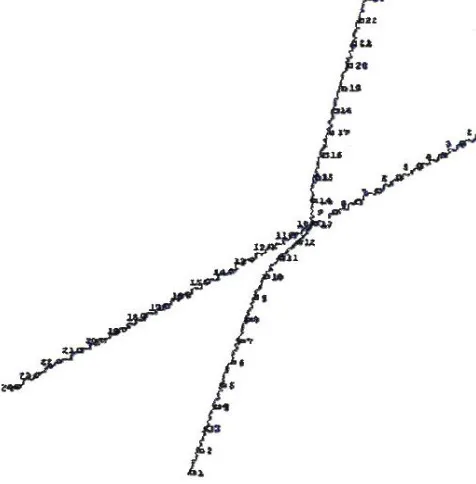Abstract— The paper aims to develop an intelligent controller to control the ship trajectory. This requires a procedure to acquire the control rules for a moving ship to avoid collision with another moving object and then steer back to reach a certain destination. This objective can be achieved by applying fuzzy logic approach. A linear 4 Th order mathematical model is developed to represent the ship dynamics. The model and the control algorithm are simulated on a PC using C++ language. The obtained results affirmed that the proposed control algorithm is powerful to realize the tracking and regulation objectives.
Index Term— Intelligent, Control, Fuzzy, Collision Avoidance
I. INTRODUCTION
Many procedures for improving the performance of control systems are based on the control strategies of human operators have already been published [1-9]. Pierre developed an on-board real—time expert system for controlling engineering systems [1]. Gilles and Pierre [2] proposed approach adopted for developing real-time expert systems by adding real-time functions to AI systems. A fuzzy guidance controller is developed for waypoint following guidance on a small autonomous boat by Vaneck [3]. The present authors have already described a method for the automatic acquisition of control strategy and tactics from operator-generated data using fuzzy neural networks [4, 5]. Cheng and Liu present a new space model for collision avoidance using genetic algorithm [6, 7]. Yu and others designed ship intelligent agent architecture, and proposed seven basic units [8]. Realization of integration technology, of ship collision avoidance system, based on high level architecture, studded by wang and others [9].
Fuzzy logic provides a practical, inexpensive solution for controlling complex or ill-defined systems. The idea of fuzzy sets is introduced by Lotfi Zadeh in his seminal papers published around 1965 [10]. Fuzzy theory is primarily concerned with quantifying and reasoning using natural language in which many words have ambiguous meanings, tall, hot, dangerous, a little, very much, and so on.
The main objective of this paper is to acquire the control rules for a moving ship to avoid collision with another moving object and then steer back to reach a certain
destination. This objective can be achieved by applying fuzzy controller.
The paper is organized as following; in Section 2, an overview of fuzzy logic system is given. Section 3, is devoted to treat the problem of collision avoidance. In Section 4, a ship collision avoidance system is designed using the fuzzy controller. Section 5, involves the simulation results with external disturbances at the track and without its. In Section 6, comparison and parameters sensitivity analysis are presented. Section 7, involves the Conclusions and suggestions for future work.
II. FUZZYLOGIC
The idea of fuzzy sets introduced by Lotfi Zadeh in his seminal papers published around 1965 [10]. Fuzzy theory is primarily concerned with quantifying and reasoning using natural language in which many words have ambiguous meanings, tall, hot, dangerous, a little, very much, and so on [11].
Fuzzy logic provides a practical, inexpensive solution for controlling complex or ill-defined systems. Despite its contradictory-sounding name, fuzzy logic offers a rigorous framework for solving many types of control problems. Rule-based fuzzy controllers require less code and memory and do not need heavy number-crunching or complex mathematical models to operate. All that is really needed is a practical understanding of the overall system behavior.
Using fuzzy logic to reach a crisp solution to a specific problem usually involves three steps: fuzzifier, fuzzy inference engine, and defuzzifier. Fig. l, shows basic configuration of fuzzy logic system with fuzzifier and defuzzifier.
Fig.1. Basic configuration of fuzzy logic system.
The fuzzy logic system with fuzzifier and defuzzifier has many attractive features. First, it is suitable for engineering systems
An Intelligent Control System for
Ship Collision Avoidance
Alaa Damen Shtay
1, Wahed Gharib
21
Community College in ALqeeyah, King Saud University, Kingdom Saudi Arabia. 2
Engineering Faculty, Ain Shams University, Egypt
Rules
Input Mem bership
Functions Output Mem bership
Functions
Fuzzifier Defuzzifie
r
Crisp input Crisp output
because its inputs and outputs are real-valued variables. Second, it provides a natural framework to incorporate fuzzy - IF -THEN rules form human experts. Third, there is much freedom in the choices of fuzzifier, fuzzy inference engine, and defuzzifier, so that we may obtain the most suitable fuzzy logic system for a particular problem. Finally, we can develop different training algorithms for this fuzzy logic system so that it provides an effective framework to integrate numerical and linguistic information. One of the most commonly used defuzzifier techniques is called the Center of Gravity (COG) or centroid method [12, 13].
III. STEERINGOFASHIPWITHINERTIA
The single manipulated variable of the operator’s ship is the steering angle u. The equations below are taken to be a simplified model of the ship’s dynamics [4] (the reduced order model is used to obtain a simple controller design).
) ( ) (t kut w
dt dw
T (1)
dt
t
d
t
w
(
)
(
)
(2))
(
sin
t
V
dt
dx
(3))
(
t
con
V
dt
dy
(4)
'
(5)Where T is the time constant (T=2 sec). V is the velocity of the operator’s ship and |V| is the speed, u is the steering angle, w is the angular velocity, θ is the angular deviation from the north, k is a constant (k=2), (x, y) is the Cartesian ship position, and η is external disturbances (from currents and wind).
Fig. 2, shows the terms used to describe the position of the operator’s ship relative to another ship and the goal. The distance between the ship and the other ship is denoted by D. The angle between the direction of the operator’s ship and the direction of the other ship viewed from the operator’s ship is
denoted by δo. In the same way, the angle between the
direction of the operator’s ship and the direction of the goal
viewed from the operator’s ship is δG. VR is the relative velocity
of the operator’s ship (moving at V) with respect to another
ship (moving at Vo). The angle formed by VR and the direction
vector of the operator’s ship will be referred to as ϕ.
When ϕ is near zero the other ship is approaching the operator’s ship nearly headed on. When ϕ is positive the other ship should pass in front of the operator’s ship, and when ϕ is negative the other ship should pass behind the operator’s ship. As the other ship approaches the operator’s ship ϕ approaches 90 (or -90) degrees: once the two ships have reached maximum proximity their positions begin to diverge, the value of ϕ increase (or decreases), and the relative distance D is proposed a negative value.
Fig. 2. Simulation parameters.
Equations for computation algorithm are:
2 1 2
1 ') ( ')
(x x y y
D (6)
)
(
tan
1 2 1 2 1y
y
x
x
G
(7)
)
'
'
(
tan
1 1 1y
y
x
x
O (8)
VR
y
y
x
x
)
'
'
(
tan
1 1 1 (9)Where: tan1( )
OY Y OX X VR V V V V
, V is velocity of the
operator’s ship, VO is velocity of the other ship, (x1, y1) is the
Cartesian operator’s ship, (x2, y2) is the Cartesian goal, and (x’, y’) is the Cartesian other ship.
The unit of the distance between the ships is defined here to be a dot on the CRT screen. There are 640 x 480 dots on the CRT screen [4].
IV. FUZZYCONTROLLER
We simplify the fuzzy controller structure in order to limit the number of input variables up to two for each table. In this method, we have four fuzzy controllers.
Fig. 3, shows the block diagram of the fuzzy controller.
Fig. 3. Block diagram of fuzzy controller
The first one is coarse fuzzy controller, it has two inputs (D,
ϕ), and one output (δRl). Where, the membership functions for
the (D, ϕ) are given in fig. 4.
Moreover, we use the rules in the table (I). North
Goal Other
Ship
Angular Velocity w
Current Position (x,y) V
VO
VR
D ϕ
δO
δG θ
X Y D ϕ δO δG Coarse Fuzzy Controller Fine Fuzzy Controller Fuzzy Controller 1 Fuzzy
Controller 2 Ship
δR
1
δR
2
δR
w u w
TABLE I
AVOIDING FUZZY RULES FOR THE δRl.
δ
R1The angle of relative
velocity ϕ
Rear Approachin
g
Fore
D
is
ta
n
c
e
D
Far A1 A2 A1
Near A1 A3 A4
Gone A1 A1 A5
The second one is fine fuzzy controller, it has two inputs (δO,
δG), and one output (δR2). Where, the membership functions for
the (δO, δG) are given in fig. 4.
Moreover, we use the rules in the table (II).
TABLE II
AVOIDING FUZZY RULES FOR T HE δR2.
δ
R2Direction δO
Left Fore Right
G
o
a
l
δG
Left Left Left Left
Fore Small
left Fore
Small right
Right Right Right Right
The third one is fuzzy controller l, it has two inputs (δR1, δR2),
and one output (δR). Where, we use the rules in the table (III).
TABLE III
AVOIDING FUZZY RULES FOR T HE δR
δ
Rδ
R1A1 A2 A3 A4 A5
δ
R2L 0 1 19 -32 -18
S.L 0 0 -19 -4 -1
F 0 9 16 -7 0
S.R 0 -1 19 4 2
R 0 0 -19 32 16
The fourth one is fuzzy controller 2, it has two inputs (δR, w),
and one output (u). We use the rules in the table (IV). Where the command u, go to the ship’s model (ship’s dynamics (1-4).
T ABLE IV
FUZZY CONTROL RULES FOR THE COMMAND u
Command u
Angular velocity w
Left Straight Right
D
ir
e
c
ti
on
δR
Left -19.7 -12.8 -10.0
Fore 2.8 0.0 -2.8
Right 10.0 12.8 19.7
V. SIM ULATIONRESULTS
The membership functions for the (D, ϕ, δO, δG) are given in
fig. 4.
Fig. 4. Membership functions for direction command.
Where the membership functions for the (δR, w) are given in fig. 5.
Fig. 5. Membership functions for steering command.
Fig. 6, shows simulation results with fuzzy controller. Where the other ship comes from 45 (deg) to the left at k = 2, T = 2 and η = 0. Where operator’s ship indicated with rectangles. The operator’s ship starts to avoid collision at rectangle number ten, and backs to its track at rectangle number thirteen. The maximum proximity is 108 (dot).
0 0
1
0.5
-400 400 800
Gone Near Far
Distance D (dot)
0 1
0.5
0 -10
-30 -20 10 20 30
Left Fore Right
Direction δO (deg)
0 1
0.5
0 -10
-30 -20 10 20 30
Rear Approach Fore
Relative angle ϕ (deg)
0 1
0.5
0 -10
-30 -20 10 20 30
Left Fore Right
Goal δG (deg)
0 0
1
0.5
40
-40 -20 20
Left Fore Right
Direction command δR (deg) 0 1
0.5
0 -2
-6 -4 2 4 6
Left Straight Right
Fig. 6. Simulation with fuzzy controller. T he other object comes from 45 (deg) to the left
Fig. 7. Simulation with fuzzy controller. T he other object comes from 30 (deg) to the right
Fig. 7, shows simulation results with fuzzy controller, where the other ship comes from 30 (deg) to the right at k = 2, T = 2 and η = 0. The operator’s ship starts to avoid collision at rectangle number ten, and backs to its track at rectangle number fifteen. The maximum proximity is 110 (dot).
Fig. 8, shows simulation results with fuzzy controller, where the other ship is head on at k = 2, T = 2 and η = 0. The operator’s ship starts to avoid collision at rectangle number two, and backs to its track at rectangle number twenty -four. The maximum proximity is 185 (dot).
Fig. 8. Simulation with fuzzy controller. T he other object is on head.
In the preview simulations, we used η = 0, but we will suppose η ≠ 0 → θ=θ’+ η and η ≤ (0.1 maximum θ).
Fig. 9, shows simulation with fuzzy controller, where the other ship comes from 45 (deg) to the left at k = 2, T = 2 and η≠ 0. Where operator’s ship indicated with rectangles. The operator’s ship starts to avoid collision at rectangle number ten, and backs to its track at rectangle number thirteen. The maximum proximity is 88 (dot).
Fig. 10. Simulation with fuzzy controller η ≠ 0. T he other object comes from 30 (deg) to the right
Fig. 11. Simulation with fuzzy controller η ≠ 0. T he other object is on head.
Fig. 10, shows simulation with fuzzy controller, where the other ship comes from 30 (deg) to the right at k = 2, T = 2 and η ≠ 0. The operator’s ship starts to avoid collision at rectangle number ten, and backs to its track at rectangle number fourteen. The maximum proximity is 56 (dot).
Fig. 11, shows simulation with fuzzy controller, where the other ship is head on at k = 2, T = 2 and η ≠ 0. The operator’s ship starts to avoid collision at rectangle number two, and backs t o its track at rectangle number twenty-four. The maximum proximity is 160 (dot) η < 0.05 maximum θ. In this case, the ship cannot avoid collision when η > 0.05 so η must be <0.05.
VI. COMP ARISON AND PARAMETERS SENSITIVITY ANALYSIS We comparison between expert and fuzzy controllers. Sensitivity analysis for system parameters is achieved to find the best design parameters.
We select as performance measure criterion, three factors:
1- 1- the maximum proximity (minimum risk of collision)
(minimum) 2
1 2
1 ') ( ')
(x x y y
D (10)
2- 2- minimum energy= (
n
i
t
u
or
dt
u
0 2 2
) (11)
3- 3- smoothing in direction =
j
j
j
)
(
1
)
2(
(12)in table (V), we compare between control approaches in (maximum proximity, sum of energy, number of rules and smoothing in direction) at k=2, T=2, η=0, and the other ship comes from 45 (deg) to the left.
TABLE V
COMP ARISON BETWEEN CONTROL AP P ROACHES (η=0)
Control approach
Maximum proximity
Sun of energy
Number of rules
Smoothing in direction Expert
controller
90 89*102 90 195
Fuzzy controller
108 96*102 52 182
From the table (V), we find fuzzy controller has the best maximum proximity, smaller number of rules (simple controller), and smoothing in direction.
VII. CONCLUSIONS
In this paper, a fuzzy controller is used to control the direction and steering of ship. The system under consideration to be controlled is a moving ship to avoid collision with another moving object and then steer back to reach a certain destination. The system is s tudied with disturbances (currents and wind effect) and without it.
navigator is reduced to very limited level because the variables are determined automatically, also it is appropriate for real time because processor computes the variables. Suggestion for future, the work may be deal with multiple object avoidance, or multivariable case (direction and speed).
REFERENCES
[1] Pierre Morizet -Mahoudeaux, "On-Board and Real-T ime Expert
Control," IEEE Expert, Vol. 11, No. 4, pp. 71 -81, August 1996. [2] G. Gerlinger and P. Morizet -Mahoudeaux, “ A Fully Integrated
Real-T ime Multitasking Knowledge-Based System: Application to an On-Board Diagnostic System," Proc. Eighth IEEE Conf Artificial Intelligence for Applications, IEEE Press, Piscataway, N.J., pp. 310-316, 1992.
[3] T . W. Vaneck, "Fuzzy Guidance Controller for an Autonomous Boat," IEEE Control Systems, pp.43 -51, April 1997.
[4] Ichiro Hiraga, T akeshi Fumhashi, Yoshiki Uchikawa, and shoichi Nakayama, "An Acquisition of Operator’s Rules for Collision Avoidance Using Fuzzy Neural Networks," IEEE T ransactions on Fuzzy Systems, Vol. 3, No. 3, pp. 280 - 287, August 1995. [5] S.Nakayama, T .Fumhashi, S.Horikawa, and Y.Uchikawa,
"Knowledge Acquisition for Control Strategy and T actics Using Fuzzy Neural Networks," J.Japan Soc. Fuzzy T heory Syst, vol. 4, no. 5, pp. 557-571. 1992.
[6] X.D. Cheng, Z.Y.Liu and X.T .Zhang, "T rajectory Optimization for Ship Collision Avoidance System Using Genetic Algorithm," IEEE OCEANS’06 ASIA PACIFIC, Singapore, 1-6, 2006. [7] Xide Cheng and Zuyuan Liu, "T rajectory Optimization for Ship
Navigation Safety Using Genetic Annealing Algorithm," T hird International Conference on Natural Computation (ICNC 2007) [8] Yu-Hong Liu, Zhi-Qiang Sun and Xuan-Min Du, "Modeling Ship
Behaviors as an Intelligent Agent for Collision Avoidance Simulation," Proceedings of the Sixth International Conference on Machine Learning and Cybernetics, Hong Kong, 19 -22 August 2007.
[9] Yuanhui Wang, Xiaocheng Shi, Xinqian Bian and Guoqing Xia, "Realization of Integration T echnology of Ship Collision Avoidance System Based on HLA," Proceedings of the 2007 IEEE, International Conference on Integration T echnology, March, Shenzhen, China, 20 - 24, 2007.
[10] Witold Pedrycz, "Fuzzy Control and Fuzzy Systems," Second, Extended, Edition, T yped by Abracadabra, Milton Keynes, England. Printed in Great Britain by SRP Ltd., Exeter, 1993. [11] Chuen Chien Lee. "Fuzzy Logic in Control Systems; Fuzzy Logic
Controller—Part 1," IEEE T ransactions on Systems, Man, and Cyberetics, Vol. 20, No. 2, pp. 404-418, March/April 1990. [12] Li—Xin Wang, "Adaptive Fuzzy Systems and Control,” by PT R
Prentice Hall. Prentice-Hall, Inc. A Paramount Communications Company Englewood Cliffs, New Jersey 07632, 1994.



